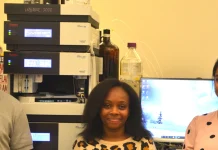Information courtesy of Kerry Pianoforte, editor, Coatings World
Radiation-curing, Highly Functional Polyurethane (Meth)acrylate
U.S. Patent 9,200,108
BASF has been granted a patent for a process for preparing a polyurethane (meth)acrylate composition, the polyurethane (meth)acrylate having a degree of branching (DB) of 10 to 99.9 percent and having less than 100 mmol of acid groups per 100g of the polyurethane (meth)acrylate. The process comprises:
- preparing an adduct, comprising one or more isocyanate groups and at least one isocyanate-reactive group, by reaction of at least one first isocyanate compound and at least one compound having isocyanate reactive groups,
- optionally, reacting the adduct via intermolecular addition to obtain a polyadduct comprising one or more isocyanate groups and optionally comprising at least one isocyanate-reactive group,
- optionally, reacting the adduct or the polyadduct with at least one compound selected from the group consisting of a monoisocyanate, the first isocyanate compound, and at least one second isocyanate compound that is different from the first isocyanate compound, and
- reaction of at least one compound from the group consisting of the adduct, the polyadduct and the reaction product from
- with an isocyanate reactive (meth)acrylate compound comprising at least one isocyanate-reactive group and at least one (meth)acrylate group, wherein the first isocyanate compound is selected from the group consisting of a diisocyanate, a polyisocyanate, and mixtures thereof,
wherein the compound having isocyanate reactive groups is selected from the group consisting of a compound having at least three isocyanate reactive groups, a compound having two isocyanate reactive groups, and mixtures thereof,
wherein at least one of the first isocyanate compound or the compound having isocyanate reactive groups comprise functional groups whose reactivity toward the functional groups of the other of the first isocyanate compound or the compound having isocyanate reactive groups is different,
wherein the more reactive groups from the first isocyanate compound or the compound having isocyanate reactive groups are substantially consumed in the preparation of the adduct,
wherein a ratio of the first isocyanate compound to the compound having isocyanate reactive groups is selected such that, on average, the adduct comprises at least one isocyanatereactive group and one or more isocyanate groups,
wherein the second isocyanate compound is selected from the group consisting of a diisocyanate, a polyisocyanate, and mixtures thereof, and
wherein a reactive diluent is present during the preparation of the adduct, and wherein the reactive diluent is selected from the group consisting of ethylene glycol di(meth)acrylate, diethylene glycol di(meth)acrylate, triethylene glycol di(meth)acrylate, butanediol di(meth)acrylate, hexanediol di(meth)acrylate, trimethylolpropane tri(meth)acrylate, pentaerythritol tetra(meth)acrylate and 2,2-bis-4-(2-hydroxy-3-methacryloyloxy)phenyl-propane.
Radiation-curable Drumhead Membrane
U.S. Patent 9,190,039
D’Addario & Company, Inc. has obtained a patent for a drumhead and a method for coating a drumhead membrane that comprises applying a coating having cross-linkable polymeric material to the membrane and applying energy to cross-link the polymeric material; thereby, permanently adhering the material to the membrane as a play surface. The cross-linking not only hardens the coating to improve durability, but also improves the adhesion of the coating to the base film. Actinically cured coatings can completely harden in a matter of three to five seconds, with UV-cured inks being especially desirable.
Nanodiamond Combined with Polymers
US Patent 9,085,723
European company Carbodeon, Helsinki, Finland, has been granted a US patent for its technology that enables detonation-synthesized diamond particles (nanodiamonds) to be combined with polymers for use in fields such as personal electronics, LED lighting, automotive and machine tools. Diamonds are the hardest natural mineral and also one of the most thermally conductive materials known, so when nanodiamonds are mixed with thermoplastic polymers in controlled amounts, they can enable plastic materials to conduct heat at predetermined rates and/or to be highly wear-resistant. Nanodiamond-impregnated polymers can deliver heat-conducting benefits for products including LED lighting, mobile devices including cellphones and Internet-of-Things (IoT) -enabled devices of any type. The hard-wearing properties mean they also can be used in the aerospace and automotive sectors to enable longer product life in hard-wear environments.





